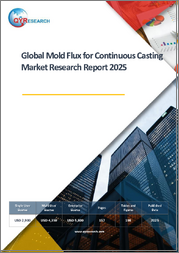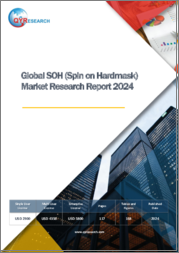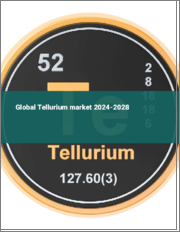
|
시장보고서
상품코드
1494914
세계의 반도체 제조 재료 시장 예측 : 재료 유형별, 반도체 유형별, 최종 사용자별, 지역별 분석(-2030년)Semiconductor Fabrication Material Market Forecasts to 2030 - Global Analysis By Material Type (Chemical Mechanical Polishing Slurry & Pads, Photomasks, Photoresist Ancillaries and Other Material Types), Semiconductor Type, End User and By Geography |
||||||
Stratistics MRC에 따르면 세계의 반도체 제조 재료 시장은 2024년에 689억 달러로 추정되고, 예측 기간 동안 CAGR 7.2%로 성장할 전망이며, 2030년에는 1,046억 달러에 이를 전망입니다.
반도체 제조 재료는 집적 회로와 같은 반도체 디바이스의 제조 공정에 사용되는 필수 물질입니다. 이들 재료는 실리콘 웨이퍼, 포토마스크, 화학기계 연마(CMP) 슬러리 및 패드, 습식 화학, 산업용 가스, 포토레지스트 등을 포함합니다. 이들 재료는 반도체 웨이퍼의 패터닝에 중요한 역할을 하며, 다양한 디바이스를 구동하는 전자 부품의 제조를 가능하게 합니다.
미국 상무부(DOC)에 따르면 반도체 공급망의 세계 반도체 시장 규모는 2020년 4,400억 달러에서 2021년에는 5,530억 달러로 25% 이상의 성장을 보였습니다.
소비자용 전자기기 수요 증가
반도체 제조 재료 시장은 소비자용 전자기기에 대한 수요 증가에 의해 크게 견인되고 있습니다. 세계 소비자가 스마트폰에서 스마트 홈 디바이스에 이르기까지 최신 가젯을 계속 찾고 있기 때문에 고급 반도체 제조 재료의 필요성이 커지고 있습니다. 이러한 재료는 이러한 장비에 전력을 공급하는 집적 회로 및 칩 제조에 필수적이기 때문에 시장 성장에 박차를 가하고 있습니다.
원재료 가격 변동
원재료 가격의 변동은 반도체 제조 재료 시장의 큰 억제요인이 되고 있습니다. 반도체 제조에 사용되는 실리콘, 금속 및 화학물질의 비용은 시장 수요, 지정학적 긴장, 공급망 혼란에 의해 크게 변동될 수 있습니다. 이러한 변화는 반도체 제조의 전체 비용에 영향을 미치고 제조업체의 수익성과 가격 전략에 영향을 미칩니다.
신흥기술 채용 확대
5G, 인공지능, 사물인터넷 등 신흥기술의 채용 확대가 반도체 제조 재료 시장에 큰 기회를 가져오고 있습니다. 이러한 기술은 보다 높은 성능과 효율을 가진 첨단 반도체 소자를 필요로 하며 이러한 까다로운 요구사항을 충족할 수 있는 혁신적인 제조 재료에 대한 수요를 이끌고 있습니다.
기술의 진부화
기술의 진부화는 반도체 제조용 재료 시장에 위협입니다. 기술의 급속한 진보는 기존의 재료와 제조 공정을 쓸모 없게 만들 수 있으며 기업은 지속적인 혁신과 적응을 강요합니다. 이러한 끊임없는 진화의 필요성은 연구개발 자원을 피폐시키고 시장 역학에 영향을 미칠 수 있습니다.
COVID-19의 영향 :
COVID-19의 유행은 반도체 제조 재료 시장에 다양한 영향을 미쳤습니다. 당초 공급망과 제조업무의 혼란이 단기적인 수요 감퇴로 이어졌습니다. 그러나 팬데믹은 디지털 전환을 가속화하여 소비자 일렉트로닉스와 커넥티비티 솔루션 수요를 증가시켰고, 결국 시장의 회복과 성장을 자극했습니다.
예측 기간 동안 실리콘 웨이퍼 부문이 최대가 될 전망
예측 기간 동안 실리콘 웨이퍼 부문이 최대가 될 전망입니다. 실리콘 웨이퍼는 반도체 제조의 기반 재료이며 대부분의 집적 회로 기판입니다. 실리콘 웨이퍼 수요는 전자기기의 세계 수요에 직결되어 시장의 중요한 부분이 되고 있습니다.
예측기간 중 CAGR은 P형이 가장 높을 것으로 예상
P-Type 부문은 예측 기간 동안 가장 높은 CAGR이 예상됩니다. P형 반도체 재료는 풍부한 정공을 형성하기 위해 도핑되어 다양한 전자 부품의 기능에 매우 중요합니다. 반도체 디바이스의 복잡화와 보다 효율적인 에너지 전도의 필요성이 P형 재료 수요를 견인하고 있습니다.
최대 점유율을 차지하는 지역 :
아시아태평양은 여러 요인들로부터 가장 큰 점유율을 자랑하며 반도체 제조 재료 시장을 독점하게 됩니다. 여기에는 중국, 한국, 대만과 같은 국가에 주요 반도체 제조 기지가 존재하고 첨단 제조 기술에 대한 많은 투자가 수요를 견인하고 있습니다. 게다가 유리한 정부 정책, 숙련 노동력, 견고한 공급망 네트워크가 반도체 제조 재료의 생산과 소비의 리더로서 이 지역의 지위를 더욱 강화하고 있습니다.
CAGR이 가장 높은 지역 :
아시아태평양도 반도체 제조용 재료 시장의 급성장이 예상되고 CAGR은 가장 높습니다. 이 지역의 성장의 원동력이 되고 있는 것은 소비자용 전자기기 수요 증가, 신기술의 채용 확대, 공업화의 진전입니다. 정부의 지원책과 급성장하는 반도체 산업의 생태계가 이 지역의 성장 예측에 기여하고 있습니다. 또한 5G, IoT, AI 등 첨단기술의 급속한 채용이 아시아태평양에서 반도체 제조 재료 수요를 더욱 촉진하고 있습니다.
무료 맞춤설정 서비스 :
이 보고서를 구독하는 고객은 다음 무료 맞춤설정 옵션 중 하나를 사용할 수 있습니다.
- 기업 프로파일
- 추가 시장 기업의 종합적 프로파일링(3개사까지)
- 주요 기업의 SWOT 분석(3개사까지)
- 지역 세분화
- 고객의 관심에 응한 주요국 시장 추계, 예측 및 CAGR(주 : 타당성 확인에 따름)
- 경쟁 벤치마킹
- 제품 포트폴리오, 지리적 존재 및 전략적 제휴에 기반한 주요 기업 벤치마킹
목차
제1장 주요 요약
제2장 서문
- 개요
- 이해관계자
- 조사 범위
- 조사 방법
- 데이터 마이닝
- 데이터 분석
- 데이터 검증
- 조사 접근
- 조사 정보원
- 1차 조사 정보원
- 2차 조사 정보원
- 전제조건
제3장 시장 동향 분석
- 성장 촉진요인
- 억제요인
- 기회
- 위협
- 최종 사용자 분석
- 신흥 시장
- COVID-19의 영향
제4장 Porter's Five Forces 분석
- 공급기업의 협상력
- 구매자의 협상력
- 대체품의 위협
- 신규 참가업체의 위협
- 경쟁 기업간 경쟁 관계
제5장 세계의 반도체 제조 재료 시장 : 재료 유형별
- 화학 기계 연마(CMP) 슬러리 및 패드
- 산업가스
- 삼불화질소(NF3)
- 불화텅스텐(WF6)
- 세정가스(CIF3,20 N)
- 벌크 가스 모노실란
- 포토 마스크
- 포토레지스트 관련 제품
- 포토레지스트
- 실리콘 웨이퍼
- 스퍼터 타겟
- 습식 화학약품
- 정전 척
- 기타 재료 유형
제6장 세계의 반도체 제조 재료 시장 : 반도체 유형별
- N형
- P형
제7장 세계 반도체 제조 재료 시장 : 최종 사용자별
- 건축
- 자동차
- 통신
- 컴퓨터
- 소비재
- 방위 및 항공우주
- 전기 및 전자
- 프린트 기판(PCB) 어셈블리
- 반도체 패키징 및 어셈블리
- 파워 일렉트로닉스의 패키징 및 조립
- 산업
- 의료 및 헬스케어
- 발전
- 운송
- 제조업
- 에너지
- 석유 및 가스
- 태양광 에너지
- 풍력 에너지
- 기타 최종 사용자
제8장 세계 반도체 제조 재료 시장 : 지역별
- 북미
- 미국
- 캐나다
- 멕시코
- 유럽
- 독일
- 영국
- 이탈리아
- 프랑스
- 스페인
- 기타 유럽
- 아시아태평양
- 일본
- 중국
- 인도
- 호주
- 뉴질랜드
- 한국
- 기타 아시아태평양
- 남미
- 아르헨티나
- 브라질
- 칠레
- 기타 남미
- 중동 및 아프리카
- 사우디아라비아
- 아랍에미리트(UAE)
- 카타르
- 남아프리카
- 기타 중동 및 아프리카
제9장 주요 발전
- 계약, 파트너십, 협업 및 합작투자(JV)
- 인수 및 합병
- 신제품 발매
- 사업 확대
- 기타 주요 전략
제10장 기업 프로파일링
- Applied Materials, Inc.
- Lam Research Corporation
- Tokyo Electron Limited
- ASML Holding NV
- KLA Corporation
- SCREEN Semiconductor Solutions Co., Ltd.
- Hitachi High-Technologies Corporation
- JSR Corporation
- Sumitomo Chemical Co., Ltd.
- Shin-Etsu Chemical Co., Ltd.
- Entegris, Inc.
- ASM International NV
- Advantest Corporation
- Tokuyama Corporation
- Dow Electronic Materials
- Cabot Microelectronics Corporation
- Tokai Carbon Co., Ltd.
- Merck KGaA
- Birla Carbon
According to Stratistics MRC, the Global Semiconductor Fabrication Material Market is accounted for $68.9 billion in 2024 and is expected to reach $104.6 billion by 2030 growing at a CAGR of 7.2% during the forecast period. Semiconductor fabrication materials are essential substances used in the process of manufacturing semiconductor devices, such as integrated circuits. These materials include silicon wafers, photomasks, chemical mechanical polishing (CMP) slurry and pads, wet chemicals, industrial gases, and photoresists. They play a critical role in patterning semiconductor wafers, enabling the creation of electronic components that power a wide range of devices.
According to the U.S. Department of Commerce (DOC), the semiconductor supply chain highlights that the global semiconductor market was valued at $553 billion in 2021, up from $440 billion in 2020, representing a growth of over 25%.
Market Dynamics:
Driver:
Increasing demand for consumer electronics
The semiconductor fabrication material market is significantly driven by the increasing demand for consumer electronics. As consumers worldwide continue to seek the latest gadgets, from smartphones to smart home devices, the need for advanced semiconductor fabrication materials escalates. These materials are crucial for manufacturing the integrated circuits and chips that power these devices, thus fueling market growth.
Restraint:
Fluctuations in raw material prices
Fluctuations in the prices of raw materials pose a major restraint to the semiconductor fabrication material market. The cost of silicon, metals, and chemicals used in semiconductor manufacturing can vary widely due to market demand, geopolitical tensions, and supply chain disruptions. These fluctuations impact the overall cost of semiconductor production, affecting profitability and pricing strategies for manufacturers.
Opportunity:
Growing adoption of emerging technologies
The growing adoption of emerging technologies such as 5G, artificial intelligence, and the internet of things present a significant opportunity for the semiconductor fabrication material market. These technologies require advanced semiconductor devices with higher performance and efficiency, driving the demand for innovative fabrication materials that can meet these stringent requirements.
Threat:
Technological obsolescence
Technological obsolescence represents a threat to the semiconductor fabrication material market. Rapid advancements in technology can render existing materials and manufacturing processes outdated, forcing companies to continuously innovate and adapt. This constant need for evolution can strain research and development resources and impact the market dynamics.
Covid-19 Impact:
The Covid-19 pandemic had a mixed impact on the semiconductor fabrication material market. Initially, disruptions in supply chains and manufacturing operations led to a short-term decline in demand. However, the pandemic also accelerated digital transformation and increased demand for consumer electronics and connectivity solutions, ultimately stimulating recovery and growth in the market.
The silicon wafers segment is expected to be the largest during the forecast period
The silicon wafers segment is expected to be the largest during the forecast period. Silicon wafers are the foundational material for semiconductor manufacturing, serving as the substrate for most integrated circuits. The demand for silicon wafers is directly tied to the global demand for electronic devices, making it a critical segment in the market.
The P-Type segment is expected to have the highest CAGR during the forecast period
The P-Type segment is expected to have the highest CAGR during the forecast period. P-Type semiconductor materials are doped to create an abundance of holes, making them crucial for the function of various electronic components. The growing complexity of semiconductor devices and the need for more efficient energy conduction are driving the demand for P-Type materials.
Region with largest share:
The Asia Pacific region is set to dominate the semiconductor fabrication material market, boasting the largest share due to several factors. These include the presence of major semiconductor manufacturing hubs in countries like China, South Korea, and Taiwan, where significant investments in advanced fabrication technologies are driving demand. Additionally, favorable government policies, a skilled workforce, and robust supply chain networks further bolster the region's position as a leader in semiconductor fabrication material production and consumption.
Region with highest CAGR:
The Asia Pacific region also anticipates rapid growth in the semiconductor fabrication material market, with the highest CAGR. The region's growth is fueled by increasing demand for consumer electronics, expanding adoption of emerging technologies, and ongoing industrialization. Supportive government initiatives and a burgeoning semiconductor industry ecosystem contribute to the region's projected growth. Additionally, the rapid adoption of advanced technologies like 5G, IoT, and AI further fuels the demand for semiconductor fabrication materials in the Asia Pacific region.
Key players in the market
Some of the key players in Semiconductor Fabrication Material Market include Applied Materials, Inc., Lam Research Corporation, Tokyo Electron Limited, ASML Holding N.V., KLA Corporation, SCREEN Semiconductor Solutions Co., Ltd., Hitachi High-Technologies Corporation, JSR Corporation, Sumitomo Chemical Co., Ltd., Shin-Etsu Chemical Co., Ltd., Entegris, Inc., ASM International N.V., Advantest Corporation, Tokuyama Corporation, Dow Electronic Materials, Cabot Microelectronics Corporation, Tokai Carbon Co., Ltd., Merck KGaA and Birla Carbon.
Key Developments:
In June 2023, Semiconductor technology is critical in enabling a global digital economy. With device complexity on the rise, advanced technology scaling is harder than ever. It means finding new ways to accelerate innovation, at lower cost, across a globally distributed industry, all while reducing the industry's environmental impact. To overcome these challenges, a new paradigm must be embraced: A physical and virtual connected semiconductor ecosystem that will enable labs and fabs to unleash the power of innovation for a better world
In May 2023, Applied Materials, a maker of semiconductor fabrication equipment, plans to plow $4 billion into a collaborative research and development facility in Silicon Valley over the next seven years. The 180,000 square foot Equipment and Process Innovation and Commercialization (EPIC) Center is expected to create 2,000 engineering jobs and provide chipmakers and university researchers with a space to develop and prototype designs on next-generation process tech and pre-release equipment, if the facility comes online in 2026.
In February 2023, Applied Materials, Inc. unveiled a breakthrough in patterning technology that allows chipmakers to create high-performance transistors and interconnect wiring with fewer EUV lithography steps, thereby lowering the cost, complexity and environmental impact of advanced chipmaking.
Material Types Covered:
- Chemical Mechanical Polishing (CMP) Slurry & Pads
- Industrial Gases
- Photomasks
- Photoresist Ancillaries
- Photoresists
- Silicon Wafers
- Sputter Targets
- Wet Chemicals
- Electrostatic Chucks
- Other Material Types
Semiconductor Types Covered:
- N-Type
- P-Type
End Users Covered:
- Architecture
- Automotive
- Telecommunication
- Computers
- Consumer Goods
- Defense & Aerospace
- Electrical and Electronics
- Industrial
- Medical and Healthcare
- Power Generation
- Transportation
- Manufacturing
- Other End Users
Regions Covered:
- North America
- US
- Canada
- Mexico
- Europe
- Germany
- UK
- Italy
- France
- Spain
- Rest of Europe
- Asia Pacific
- Japan
- China
- India
- Australia
- New Zealand
- South Korea
- Rest of Asia Pacific
- South America
- Argentina
- Brazil
- Chile
- Rest of South America
- Middle East & Africa
- Saudi Arabia
- UAE
- Qatar
- South Africa
- Rest of Middle East & Africa
What our report offers:
- Market share assessments for the regional and country-level segments
- Strategic recommendations for the new entrants
- Covers Market data for the years 2022, 2023, 2024, 2026, and 2030
- Market Trends (Drivers, Constraints, Opportunities, Threats, Challenges, Investment Opportunities, and recommendations)
- Strategic recommendations in key business segments based on the market estimations
- Competitive landscaping mapping the key common trends
- Company profiling with detailed strategies, financials, and recent developments
- Supply chain trends mapping the latest technological advancements
Free Customization Offerings:
All the customers of this report will be entitled to receive one of the following free customization options:
- Company Profiling
- Comprehensive profiling of additional market players (up to 3)
- SWOT Analysis of key players (up to 3)
- Regional Segmentation
- Market estimations, Forecasts and CAGR of any prominent country as per the client's interest (Note: Depends on feasibility check)
- Competitive Benchmarking
- Benchmarking of key players based on product portfolio, geographical presence, and strategic alliances
Table of Contents
1 Executive Summary
2 Preface
- 2.1 Abstract
- 2.2 Stake Holders
- 2.3 Research Scope
- 2.4 Research Methodology
- 2.4.1 Data Mining
- 2.4.2 Data Analysis
- 2.4.3 Data Validation
- 2.4.4 Research Approach
- 2.5 Research Sources
- 2.5.1 Primary Research Sources
- 2.5.2 Secondary Research Sources
- 2.5.3 Assumptions
3 Market Trend Analysis
- 3.1 Introduction
- 3.2 Drivers
- 3.3 Restraints
- 3.4 Opportunities
- 3.5 Threats
- 3.6 End User Analysis
- 3.7 Emerging Markets
- 3.8 Impact of Covid-19
4 Porters Five Force Analysis
- 4.1 Bargaining power of suppliers
- 4.2 Bargaining power of buyers
- 4.3 Threat of substitutes
- 4.4 Threat of new entrants
- 4.5 Competitive rivalry
5 Global Semiconductor Fabrication Material Market, By Material Type
- 5.1 Introduction
- 5.2 Chemical Mechanical Polishing (CMP) Slurry & Pads
- 5.3 Industrial Gases
- 5.3.1 Nitrogen Trifluoride (NF3)
- 5.3.2 Tungsten Fluoride (WF6)
- 5.3.3 Cleaning Gas (CIF3,20%F2N)
- 5.3.4 Bulk Gas Monosilane
- 5.4 Photomasks
- 5.5 Photoresist Ancillaries
- 5.6 Photoresists
- 5.7 Silicon Wafers
- 5.8 Sputter Targets
- 5.9 Wet Chemicals
- 5.10 Electrostatic Chucks
- 5.11 Other Material Types
6 Global Semiconductor Fabrication Material Market, By Semiconductor Type
- 6.1 Introduction
- 6.2 N-Type
- 6.3 P-Type
7 Global Semiconductor Fabrication Material Market, By End User
- 7.1 Introduction
- 7.2 Architecture
- 7.3 Automotive
- 7.4 Telecommunication
- 7.5 Computers
- 7.6 Consumer Goods
- 7.7 Defense & Aerospace
- 7.8 Electrical and Electronics
- 7.8.1 Printed Circuit Board (PCB) Assembly
- 7.8.2 Semiconductor Packaging and Assembly
- 7.8.3 Power Electronics Packaging and Assembly
- 7.9 Industrial
- 7.10 Medical and Healthcare
- 7.11 Power Generation
- 7.12 Transportation
- 7.13 Manufacturing
- 7.14 Energy
- 7.14.1 Oil & Gas
- 7.14.2 Solar Energy
- 7.14.3 Wind Energy
- 7.15 Other End Users
8 Global Semiconductor Fabrication Material Market, By Geography
- 8.1 Introduction
- 8.2 North America
- 8.2.1 US
- 8.2.2 Canada
- 8.2.3 Mexico
- 8.3 Europe
- 8.3.1 Germany
- 8.3.2 UK
- 8.3.3 Italy
- 8.3.4 France
- 8.3.5 Spain
- 8.3.6 Rest of Europe
- 8.4 Asia Pacific
- 8.4.1 Japan
- 8.4.2 China
- 8.4.3 India
- 8.4.4 Australia
- 8.4.5 New Zealand
- 8.4.6 South Korea
- 8.4.7 Rest of Asia Pacific
- 8.5 South America
- 8.5.1 Argentina
- 8.5.2 Brazil
- 8.5.3 Chile
- 8.5.4 Rest of South America
- 8.6 Middle East & Africa
- 8.6.1 Saudi Arabia
- 8.6.2 UAE
- 8.6.3 Qatar
- 8.6.4 South Africa
- 8.6.5 Rest of Middle East & Africa
9 Key Developments
- 9.1 Agreements, Partnerships, Collaborations and Joint Ventures
- 9.2 Acquisitions & Mergers
- 9.3 New Product Launch
- 9.4 Expansions
- 9.5 Other Key Strategies
10 Company Profiling
- 10.1 Applied Materials, Inc.
- 10.2 Lam Research Corporation
- 10.3 Tokyo Electron Limited
- 10.4 ASML Holding N.V.
- 10.5 KLA Corporation
- 10.6 SCREEN Semiconductor Solutions Co., Ltd.
- 10.7 Hitachi High-Technologies Corporation
- 10.8 JSR Corporation
- 10.9 Sumitomo Chemical Co., Ltd.
- 10.10 Shin-Etsu Chemical Co., Ltd.
- 10.11 Entegris, Inc.
- 10.12 ASM International N.V.
- 10.13 Advantest Corporation
- 10.14 Tokuyama Corporation
- 10.15 Dow Electronic Materials
- 10.16 Cabot Microelectronics Corporation
- 10.17 Tokai Carbon Co., Ltd.
- 10.18 Merck KGaA
- 10.19 Birla Carbon



















